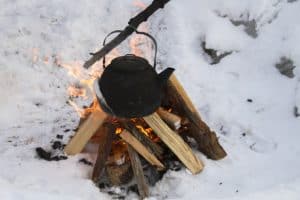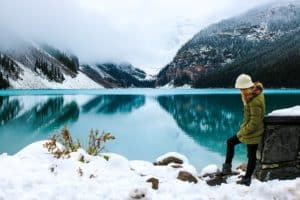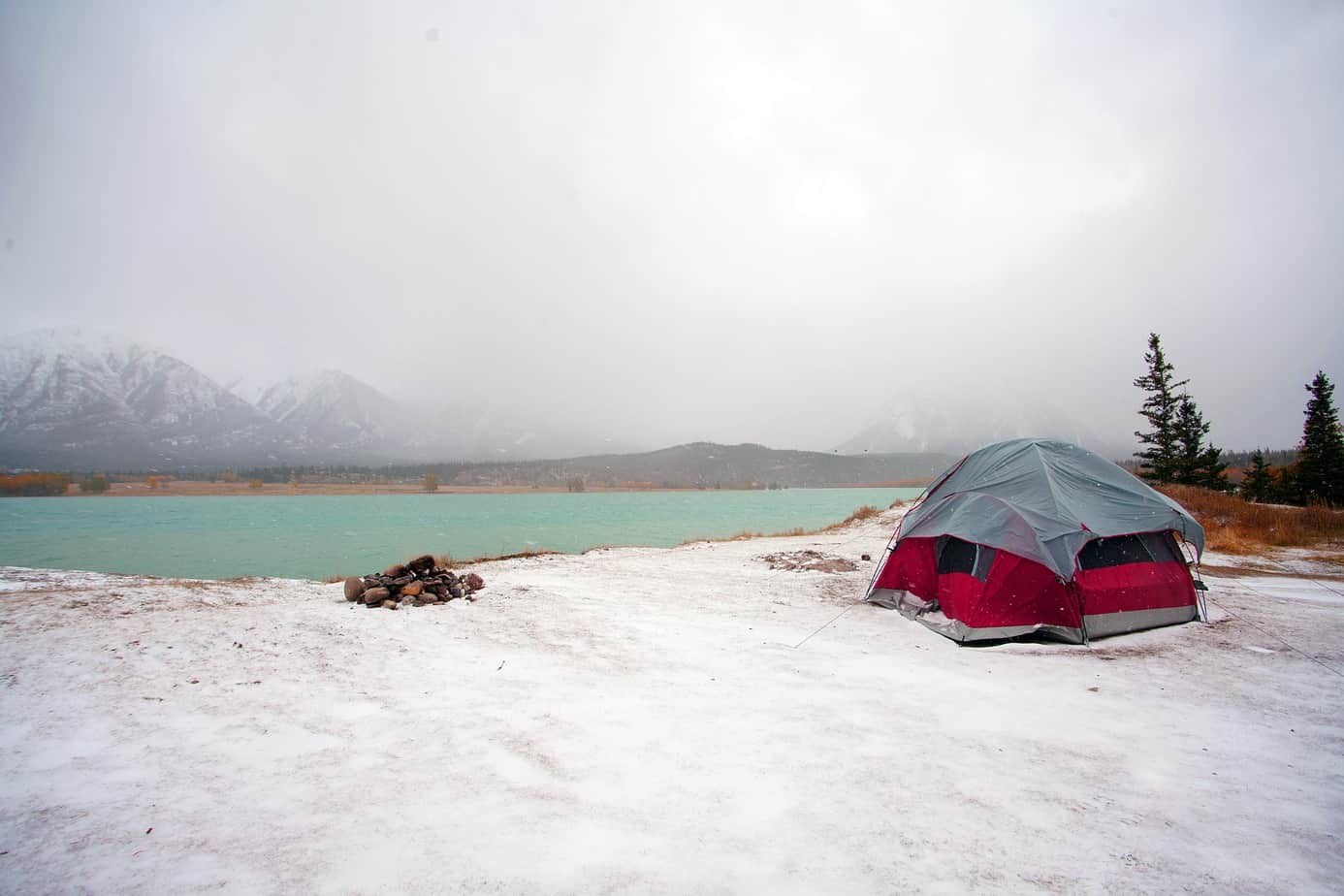An often overlooked but great time of the year to go camping is during the winter but it’s important to know how to camp in the winter before heading out.
While many basic camping principals that apply in warm-weather camping still apply during winter camping, there are many additional issues and concerns you must be aware to safely winter camp.
How to Camp in the Winter – Four Basic Concerns
Winter can be a great time of the year to go camping because there are fewer crowds and bugs, allowing you to experience nature in peaceful quiet and solitude.
In order to safely camp in the winter though there are four basic concerns that must be addressed when learning how to camp in the winter including shelter, clothing, food and water, and injury prevention.
Obviously, one of the biggest issues while winter camping is insulating yourself from cold temperatures and potentially dangerous weather. So in this article, we will be taking a look at each of these four main elements to provide you with best practices and ways to stay safe and warm while winter camping.
Winter Camping and Shelter
When winter camping having a well out laid out and quality shelter is of the utmost importance for comfort and safety.
The first thing to do while winter camping is to look for and prep the campsite. When looking for a good winter campsite you want to look for an area that has a natural break from the weather and wind such as a grouping of trees or against an embankment to cut down on wind and to provide some natural protection against incremental winter weather.
The worse thing you can do while winter camping is to set up your campsite in the middle of a barren field as you will be completely exposed and have no protection from winter weather.
Once you’ve found a campsite that provides natural protection from the elements the next thing to do is to make sure the campsite is safe. There are two main dangers when it comes to winter campsites which include avalanches and widow makers.
So before you set your tent up make sure there is no danger from an avalanche and that your campsite is not located under any large trees or branches that look dead or unhealthy. As it’s common during the winter especially during high winds for large dead branches to break away from trees and come crashing down.
A few other niceties to look for when picking your winter campsite include a location close to the water and a campsite that will receive ample morning sunlight to help warm you up on those cold winter mornings.
How to Camp in the Winter and Setting Up Your Winter Campsite
Once you’ve found that perfect winter campsite it time to start setting up camp.
The first thing you want to do if camping on snow is to stomp down the snow in the area you plan to set the tent up. This is beneficial for two reasons the first being that it will provide a more even and comfortable night’s sleep and the second is that it will prevent damaging your tent by stepping through the tent on soft snow.
Before you set up your tent it’s a good idea to lay a ground cover down to set the tent on. By laying the ground cover down first it will help to keep your tent dry and provide an additional layer of protection from the cold ground and muck.
When it comes to tents and winter camping, not just any tent will do as it’s important to use a 3 or 4 season tent specifically designed for cold weather and winter camping. If your tent doesn’t have a 3 or 4 season rating and you don’t think it will hold up to rigors of winter camping check out our article on “Extreme Cold Weather Tents for Winter Camping” to help pick out a tent that will.
While you might not need much protection while camping in warm or milder weather, you need all the protection your tent can offer during the winter, so it’s important to have and install the tents waterproof rainfly to prevent water from leaking into the tent and to secure all guy lines to prevent the tent from collapsing during high winds.
Also if your camping on snow it’s important to use tent stakes designed for snow or bury weighted stuff sacks in the snow, as regular tent stakes will do little good.
Cold Weather Camping Gear for Inside the Tent
Now that the tent is set up it’s important to talk about the best gear to use inside the tent to stay warm and safe while winter camping.
The two most important pieces of winter camping gear to keep you warm inside the tent are the sleeping bag and sleeping pad.
When choosing a winter sleeping bag you should pick a sleeping bag that is rated for at least 10 degrees colder than the temperatures you expect on your camping trip. Don’t worry about getting hot in your sleeping bag while camping in the winter as this is an easy situation to remedy while winter camping.
It’s important to remember that tents offer very little if any insulating qualities so the only way you are going to stay warm and hold in the body heat is by using a cold-weather sleeping bag appropriate for winter camping.
The other important piece of gear to use inside the tent to stay warm is a quality sleeping pad. Using a sleeping pad under your sleeping bag is crucial to staying warm while sleeping in a tent because it provides an additional layer of separation between you and the frigid ground.
In fact, it’s not uncommon for cold-weather campers to actually use two sleeping pads to provide even more protection from the cold ground.

Cold Weather Camping and Campfires
Once your tent is fully set up you want to get that campfire going to provide a source of warmth while around your campsite.
When building a campfire during the winter it’s important to have some sort of windbreak and barrier around the fire to keep the fire contained and to protect the fire from high winds. If you have access to large stones these can be a great choice because not only will they help to block the wind but they will also absorb and radiate heat even as the fire dies down.
Miscellaneous Cold Weather Campsite Niceties
Once the fire is set up you can then turn your attention to other creature comforts to help the campsite feel more like home, this might include stomping down additional snow around the campsite to provide a more even and stable walking surface, or setting up a table and camp chairs to keep you and your gear off the cold and wet ground and out of the snow and muck.
Winter Camping and Clothing
When it comes to clothing while winter camping it’s all about the layers.
If you plan to camp during the winter and cold weather it’s important to have several layers of clothing on for temperature control. By wearing several layers of clothing you will be better able to stay warm when the temperature starts to drop but also cool down easier when the sun pops out in the middle of the day by shedding some layers of clothing.
There are 3 layers of clothing you should wear while winter camping including the base layer, the middle layer, and the outer layer.
Base Layer
The base layer is the underwear that will come in direct contact with the skin. The best type of base layer you can wear while winter camping is long underwear made from polyester or wool as it will provide a ton of warmth but also wick sweat away from the skin and dry out quickly.
When shopping for long underwear remember that there are different weights for milder or colder winter weather, so make sure to pick a thickness that is appropriate to the type of cold weather you will encounter while camping.
Middle Layer
The middle layer of clothing provides insulation from the cold weather and helps to retain body heat.
Great materials for the middle layer of clothing while in the cold include a puffy down, synthetic material, or fleece.
Also, don’t forget as a general rule of thumb the puffier the jacket the more protection it will offer from cold weather and the warmer the material will keep you.
Outer Layer
The outer layer or sometimes referred to as the “shell layer” is the waterproof layer of clothing that provides protection from wet weather you are likely to encounter while winter camping.
Don’t make the mistake of choosing a water-resistant jacket or pants while winter camping as they will quickly fail while winter camping. Instead, make sure you choose jackets and pants that are completely waterproof in order to stay nice and dry while winter camping.
Cold Weather Clothing Accessories
Now that the basic layers of clothing are covered it’s important to remember that there are many different winter weather accessories that can provide a ton of additional protection from the harsh winter weather.
Some great winter weather items that can really help to keep you warm include multiple pairs of thick non-cotton socks, a tobogin to help keep your head warm, a pair of waterproof gloves, and a pair of sunglasses as the snow can be very blinding while the suns out.
Winter Camping – Food and Water
The importance of food and water can not be understated while winter camping. As winter camping and hiking can really burn through your body’s resources.
So if you plan to camp or hike during the winter it’s important you are consuming plenty of food and water to keep your body fueled and hydrated.
While winter camping it’s usually best to keep things as simple as possible and food and water are no exception.
A hot and simple one-pot meal can go along way in keeping you warm and happy while winter camping.
Also, it can be easy to forget about staying hydrated and drinking water while winter camping because you are less likely to feel thirsty while in the cold as you are when it’s hot outside. So make sure to make a conscious effort throughout the day to drink plenty of water.

How to Camp in the Winter and Stay Injury Free
While winter camping can be fun and exciting it can also be dangerous if proper care and caution are not taken.
During winter camping the most common injuries include frostbite or hyperthermia from cold weather exposure or slip and fall injuries from ice or snow.
A little preparedness and caution though can go along way in keeping you safe and injury-free while winter camping. Below are our top safety tips for winter camping.
Safety Tips for Winter Camping
- Limit your exposure to cold weather by having appropriate cold-weather gear and clothing.
- Cover all skin and never leave skin exposed for long periods of time.
- Pay attention to your body, if your beginning to feel cold or your fingers or toes are getting cold don’t ignore the issue, instead, stop what you’re doing and address the problem.
- Don’t ignore small issues. Ignoring small issues while winter camping can often lead to much bigger issues.
- Have a buddy and stay in constant contact. When winter camping there is safety in numbers.
- Always check up on your fellow campers to make sure they are staying warm and are not having any issues.
- Don’t get in a hurry and pay attention to your surroundings while winter camping or hiking. As many injuries stem from campers or hikers being careless or not paying attention.
- Always wear appropriate footwear while winter camping which is a good sturdy pair of waterproof boots.
- Focus on keeping your body temperature regulated as opposed to going through constant cycles of hot and cold.
- Make sure to drink plenty of water to avoid becoming dehydrated.
- Bring plenty of food while winter camping as this is a great way to stay warm in cold weather.
How to Camp in the Winter Conclusion
While camping in the winter can be challenging, we hope we have shown that with a little preparedness and caution any camper can beat back the cold in order to enjoy one of the most peaceful and serene camping seasons of the year.

